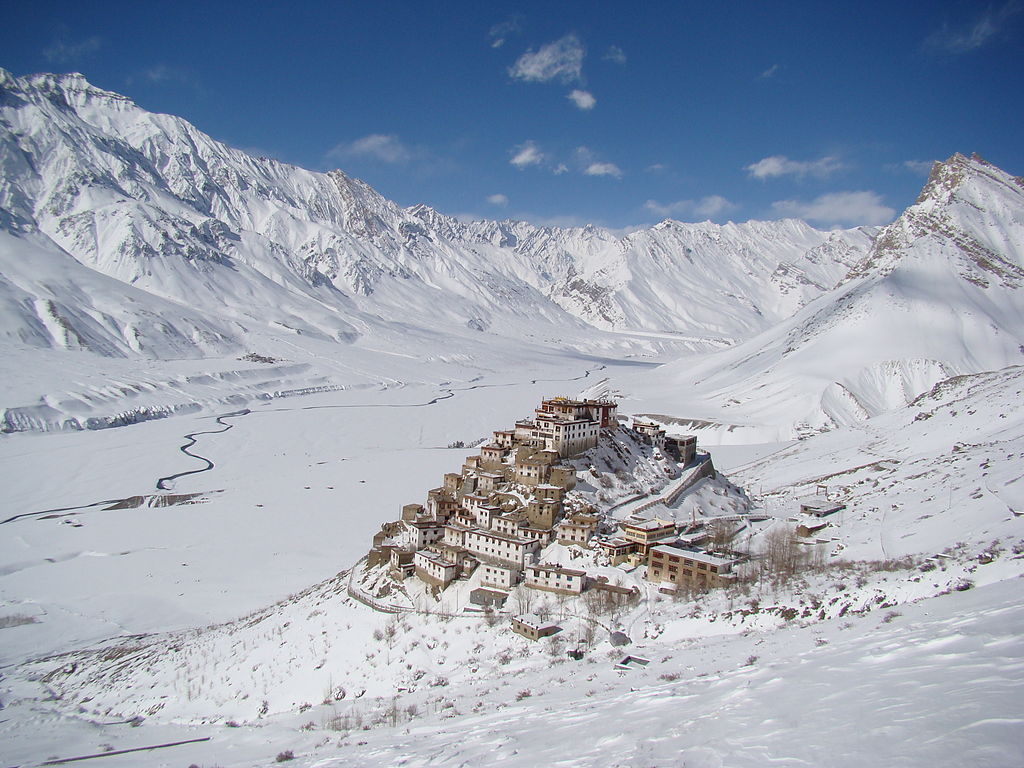Kye Gompa (also spelled Ki, Key or Kee – pronounced like English key) is a Tibetan Buddhist monastery located on top of a hill at an altitude of 4,166 metres (13,668 ft) above sea level, close to the Spiti River, in the Spiti Valley of Himachal Pradesh, Lahaul and Spiti district, India.
Shrine’s History
Kye Gompa is said to have been founded by Dromtön (Brom-ston, 1008-1064 CE), a pupil of the famous teacher, Atisha, in the 11th century. This may however, refer to a now destroyed Kadampa monastery at the nearby village of Rangrik, which was probably destroyed in the 14th century when the Sakya sect rose to power with Mongol assistance. Kye was attacked again by the Mongols during the 17th century, during the reign of the Fifth Dalai Lama, and became a Gelugpa establishment. In 1820 it was sacked again during the wars between Ladakh and Kulu.
In 1841 it was severely damaged by the Dogra army under Ghulam Khan and Rahim Khan. Later that same year suffered more damage from a Sikh army. In the 1840s it was ravaged by fire and, in 1975, a violent earthquake caused further damage which was repaired with the help of the Archaeological Survey of India and the State Public Works Department. The walls of the monastery are covered with paintings and murals, an example of the 14th century monastic architecture, which developed as the result of Chinese influence. Kye Gompa now belongs to the Gelugpa sect, along with Tabo Monastery and Drangtse Monastery, one of three in Spiti. “The monastery of Kee, for instance, accommodates nearly 250 monks, who reside within the sacred walls in winter, and stay during the summer with their parents or brothers, working in the fields, or employed in carrying travellers’ goods. These monasteries have their regular headsor abbots, and the higher ecclesiastical titles can only be obtained by the candidates proceeding in person to either Shigatzee (Shigatse) or Lhassa (Lhasa).” A celebration of its millennium was conducted in 2000 in the presence of the Dalai Lama.
Architectural Relevance of This Shrine
In the architectural definitions given to various monasteries, Ki falls in the Pasada style which is characterised by more stories than one and often plays the role of a fort-monastery. Kye monastery has a collection of ancient murals and books, including Buddha images. There are three floors, the first one is mainly underground and used for storage. One room, called the Tangyur is richly painted with murals. The ground floor has the beautifully decorated Assembly Hall and cells for many monks.
Shrine’s Map Location and How to Go There
By Road
The monastery is around 12 km north of Kaza and can be reached by covering a distance of 210 km from Manali to Kaza. From there daily buses takes you to the Kye Monastery. Cabs and local HRTC buses from Manali via Rohtang to Kaza or from Shimla. The Best way is to reach Spiti from Chandigarh. You can take or higher a bus/taxi from Chandigarh and will reach Manali on the same day. There you will have to higher a taxi from Manali to Spiti as local taxi Union won’t allow you to take your own vehicle to relocate to Spiti. As you will start your journey from Manali, you will see many tourist places to explore like Marri, Rohtang Pass, Kunjum Pass, Surajtaal lake, Chandertaal lake and many more. The condition of road is not so good. Hiring a SUV will be good option to relocate there.
Extra Information About this Shrine
There are no accommodation options at the monastery. Tourists who visit the monastery, prefer to stay at Kaza. Kaza offers a wide range in terms of hotels, resorts and homestays. There are no restaurants or eateries at the Key Monastery. It is advisable to carry food while visiting the monastery. The monks at the monastery serve tea to all visitors. Best time for visiting Key Monastery is during summer, from May to October. From October end, Rohtang Pass remains closed due to snow fall.
